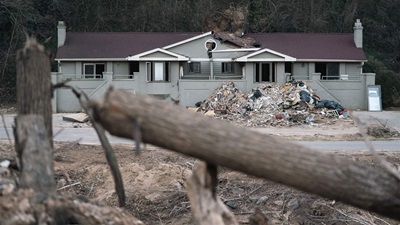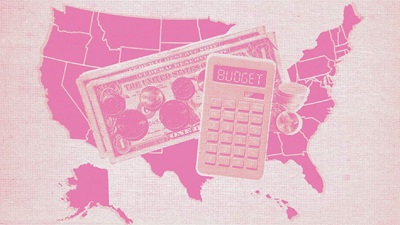Hurricane Helene’s Staggering Costs Test States’ Fiscal Resilience
North Carolina’s response highlights impact of disasters on state budgets and strategies to address risks

Hurricane Helene ravaged the southeastern United States for three days in September 2024, leaving a path of destruction and hundreds of casualties throughout North Carolina and five other states. Record-breaking rainfall devastated western North Carolina and triggered landslides that left many areas cut off from essential services for days. The mountain tourist hub of Asheville faced unprecedented destruction, including widespread property damage and disruptions to critical infrastructure.
Since the winds died down and floodwaters receded, North Carolina has faced another daunting challenge: a multibillion-dollar recovery price tag that is forcing lawmakers to confront state budget disruptions. The state Legislature has so far appropriated $1.6 billion in response to Helene. Without careful, long-term planning, that amount of unexpected state spending can disrupt other priorities, illustrating one of the key challenges that officials face as they build budgets in an environment of more expensive and severe disasters.
The mountain towns of North Carolina aren’t alone in dealing with extreme weather events. Cities in the Northeast such as Philadelphia and Boston experienced historic drought conditions in the second half of 2024, prompting officials to urge residents to reduce water use amid risks to regional supplies. In the West, wildfires have encroached on major urban areas with record intensity. Fourteen fires engulfed the Los Angeles area in January 2025, burning around 50,000 acres and killing at least 29 people.
The difficulties predicting and fully assessing damage from a catastrophic event, coupled with constrained state budgets, underscores the importance of proactive strategies for measuring and managing disaster resources. North Carolina's experience after Hurricane Helene highlights the immense costs and uncertainties, while the state's response may offer a blueprint for others to follow.
Measuring the cost
In four bills passed between October 2024 and March 2025, the North Carolina General Assembly transferred $1.4 billion from the state’s savings reserve and a dedicated disaster reserve to the newly established Hurricane Helene Fund. Lawmakers also reallocated an additional $202 million from other sources, bringing total funding to $1.6 billion.
Lawmakers were able to determine funding needs and target their allocations thanks to detailed analyses by state budget officials. The Hurricane Helene Damage Needs and Assessment, required as part of the state's Disaster Recovery Framework, provides estimates of disaster costs across agencies, identifies the range of needs, and breaks down available resources by funding source—federal, private, and existing state funds. North Carolina officials actively monitored and updated recovery funding needs as conditions evolved, tracking disruptions to critical services and infrastructure and examining long-term effects on agriculture, tourism, and uninsured property, among other areas. For example, the document estimates $5 million in damages to school nutrition programs at K-12 public schools and identifies specific state funding to make up for that loss.
But these types of assessments are not easy to produce. Some federal support is provided in assessing damages, but states must provide their own resources to overcome the inherent difficulty in understanding the true costs accrued across levels of government, agencies, and localities following a natural disaster. Nevertheless, systematic cost evaluations empower officials to proactively plan and budget for future disaster response and recovery, highlighting how comprehensive needs assessment can drive targeted funding by the state Legislature and empower officials to proactively plan and budget for future disaster response and recovery.
Proactive steps can minimize disruptions
One reason North Carolina could allocate funds toward Helene recovery is proactive savings for future uncertainties. The state had $4.75 billion in rainy day savings at the time the hurricane struck, thanks to steady deposits to its savings reserve that were required by a 2017 law. These recurring investments and sizeable fund balance helped the state address disaster response without disrupting other budgetary needs.
Although North Carolina had the resources available, the structure of the rainy day fund necessitated additional steps before funding could be deployed. The state’s savings policy requires legislative approval to access the fund for disaster recovery purposes, which contributed to a slight delay in getting the money out the door. In this urgent circumstance, the Legislature responded swiftly after the disaster and approved the withdrawal in a special session.
Rainy day funds are not the only source states use to pay for disasters. Most, including North Carolina, have statewide emergency accounts with funds exclusively earmarked for disasters. Georgia—another state hard hit by Hurricane Helene— funded its emergency response efforts with the Governor’s Emergency Fund, a statewide disaster account that can be accessed during emergencies without legislative approval.
Whether through a rainy day fund, as North Carolina has done, through a disaster-specific account, or some other mechanism, proactive budgeting helps to ensure that funding is available where it’s needed with minimal fiscal disruption in the face of increasingly frequent and severe disasters.
Final thoughts
In addition to managing the cost and budget impact of disasters after they happen, states can also manage their spending on disasters in the long term through preemptive mitigation measures. In 2021, the North Carolina Legislature budgeted $20 million to create the Flood Resiliency Blueprint, an initiative to identify watersheds most affected by flooding and provide support at the local level to jump-start projects that increase community resilience. Along with states such as Alabama and Louisiana, North Carolina has also developed insurance incentive programs that provide grants to encourage homeowners to strengthen their roofs against severe storms.
As states face potential budget constraints during this period of economic uncertainty, practices that help policymakers proactively manage fiscal risks such as natural disasters can help officials better understand damages, allocate resources effectively, and minimize budgetary disruption. Disasters are a nationwide challenge; 40 U.S. states received federal major disaster declarations in 2024 alone. As storms increase in frequency and severity, states must take on the vital role of safeguarding their budgets against mounting recovery costs.
Jad Maayah works with The Pew Charitable Trusts’ managing fiscal risks project.










